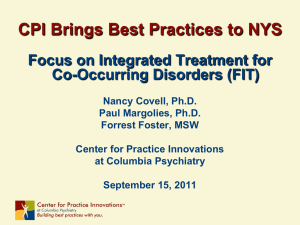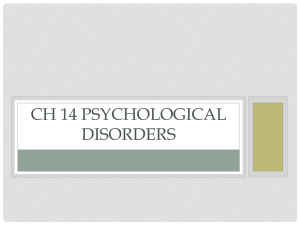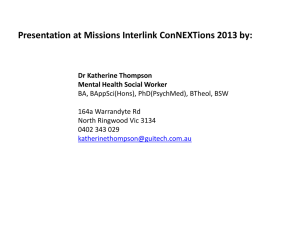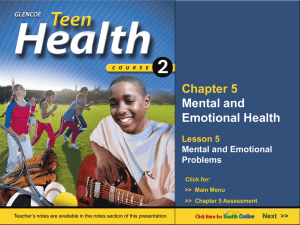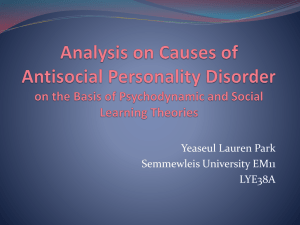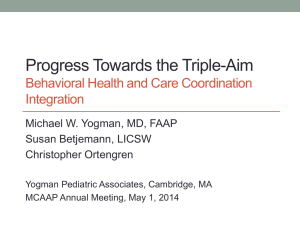Research & Treatment of Persons with Substance Use & Psychotic
advertisement
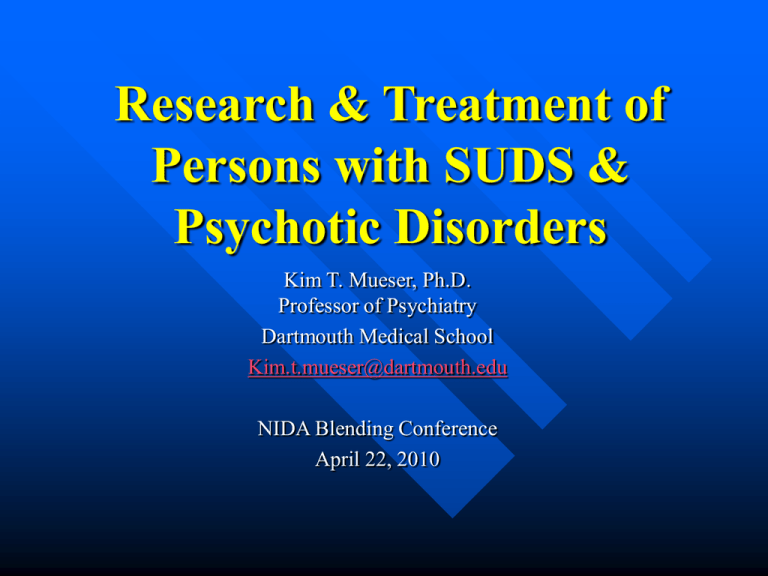
Research & Treatment of Persons with SUDS & Psychotic Disorders Kim T. Mueser, Ph.D. Professor of Psychiatry Dartmouth Medical School Kim.t.mueser@dartmouth.edu NIDA Blending Conference April 22, 2010 Overview Comorbidity of substance use & severe psychiatric disorders Distinguishing features of psychotic disorders with comorbid addiction Understanding comorbidity: models of etiology & treatment implications Special treatment needs of psychotic & other severe psychiatric disorders with comorbid addiction Research reviews of integrated treatment for cooccurring disorders New research on treatment of co-occurring disorders Resources Any Substance Use Disorder Prevalence % of Substance Use Disorder 60 50 40 30 20 10 0 Gen.Pop Schiz BPD MD OCD Phobia PD Rates of Lifetime Substance Use Disorder (SUD) among Recently Admitted Psychiatric Inpatients (N = 325) (Mueser et al., 2000) % of Clients with SUD 100 75 50 25 0 S ch iz oph re n ia S ch iz oaffective Di sorder Bi pol ar Dis orde r Major Depre ss i on Prevalence of Mental Illness in Alcohol Disorder Samples 70 60 50 40 30 20 In community, 24.4% have mental illness In institutions, 55% have mental illness In substance abuse treatment, 65% have mental illness 10 0 Community SA Treatme nt Regier et al, JAMA 1990 Severe Mental Illnesses (SMI) Psychiatric disorder that has profound effect on: – – – – People often on disability due to mental illness (e.g., SSI, SSDI) Common SMIs: – – – – – Work or school Parenting Self-care Social relationships Schizophrenia & schizoaffective disorder Bipolar disorder Major depression PTSD Borderline personality disorder Often present for treatment in psychiatric settings, but also common in addiction treatment settings Psychotic Disorders Psychosis = “Lack of contact with reality” Common psychotic symptoms: – Hallucinations – Delusions – Grandiosity – Suspiciousness – Bizarre behavior – Formal thought disorder (disordered or disorganized speech) – Conceptual disorganization Psychotic symptoms common in schizophrenia, schizoaffective & bipolar Psychotic symptoms relatively common in major depression & PTSD Presence of psychotic symptoms associated with more severe mental illness & greater co-occurring addiction Understanding Comorbidity: Why are the Rates of SMI/Psychotic Disorder so High? Self-medication Other common motives for using Super-sensitivity Common factors for mental illness & substance misuse Self-Medication Many clients report using substance for at least some reasons related to symptoms, BUT: More symptomatic clients don’t use more than less symptomatic ones No relationship between symptoms & types of substances used No relationship between psychiatric diagnosis and types of substances used Many clients report using DESPITE awareness it worsens symptoms or triggers relapses Strongest case for self-medication: alcohol use disorder in PTSD frequently related to sleep problems Self-medication/use for coping purposes is one of host of motivations related to SMI for using substances, but doesn’t explain all comorbidity Other Common Motives for Using Socialization Leisure & recreation Dealing with stress Escaping the stigma of mental illness Lack of structured time Lack of engagement in personally meaningful roles (e.g., worker, student, parent) Supersensitivity to Alcohol & Drugs Biological sensitivity increases vulnerability to effects of substances Smaller amounts of substances result in problems “Normal” substance use is problematic for clients with SMI but not in general population Sensitivity to substances, rather than high amounts of use, makes many clients with mental illness different from general population Stress-Vulnerability Model Medication Substance Abuse Biological Vulnerability Severity of SMI Stress Coping Status of Moderate Drinkers with Schizophrenia 4 - 7 Years Later (N=45) 100% 80% 60% 55.6 40% 20% 20.0 24.4 Moderate Drinker Alcohol Use Disorder 0% Abstinent Source: Drake & Wallach (1993) Common Factors for SMI & Addiction: Conduct Disorder (CD) & Antisocial Personality Disorder (ASPD) ASPD has highest addiction comorbidity of all psychiatric disorders (60-70% in most estimates) CD is powerful predictor of later onset of SUD ASPD associated with earlier onset of addiction CD & ASPD more common in SMI than general population CD/ASPD increase risk of addiction in SMI CD/ASPD related to more severe addiction in cooccurring disorders Estimated prevalence in co-occurring population: 2025% CD, ASPD, and Recent SUD in Clients with SMI (N = 293) Alcohol Use Disorder 70% 60% 50% 40% 30% 20% 10% Cannabis Use Disorder 63.2 60.0 60% 52.6 50% 41.7 36.0 40% 29.3 30% 20% 25.0 13.8 10% 0% 0% Cocaine Use Disorder 40% 36.8 30% CD Only 20% Adult ASPD Only 12.5 10% No ASPD/CD 4.9 8.0 Full ASPD 0% Source: Mueser et. al. (1999) Other Potential Common Factors Leading to Increased Comorbidity Poverty/deprivation Neurocognitive impairment Trauma Special Treatment Needs of CoOccurring SMI/Psychotic Disorder Integration of mental illness & substance use disorder treatment – Concurrent treatment – Same treatment providers – Integrated treatment of both disorders Minimization of treatment-related stress Outreach & engagement Close monitoring, especially for co-occurring disorder clients with ASPD Special Treatment Needs: Motivational Enhancement Stages of change Stages of treatment – Engagement – Persuasion – Active treatment – Relapse prevention Adapted motivational interviewing – Articulation of personal goals – Active work towards goals – Supportive self-efficacy for goal attainment & substance reduction/abstinence Motivational Enhancement (Con’d) Concept of recovery from mental illness – Recovery defined by client, not in traditional medical terms – Recovery possible despite continued symptoms – Instills hope – Common themes: social relationships, role functioning, community membership, respect for self & from other Special Treatment Needs: Management of Cognitive Impairment Smaller “chunks” of information Asking questions so client actively processes information Frequent review of material Shaping approach to reinforcing successive steps towards desired goals Patience & abundant reinforcement in light of small changes Programming generalization of skills to natural environment by – Home practice assignments – Involvement of significant others in practicing skills – Involvement of paraprofessionals in helping clients practice skills Special Treatment Needs: Training in Illness Self-Management Information about mental illness & its treatment Stress-vulnerability model Involvement of family or significant other persons Driven by personal goals Principles of relapse prevention: – Medication adherence – Minimization of alcohol & drug use – Stress reduction – Meaningful but not over-demanding daily structure – Coping & competence skills – Social support – Relapse prevention plan Special Treatment Needs: Psychiatric Rehabilitation Address motives underlying substance use Skills training to address social motives, independent living skills Coping skills training/CBT for persistent symptoms Targeted CBT to address primary or comorbid depression, anxiety, PTSD symptoms Supported employment/education for competitive work or return to school Family psychoeducation to reduce family stress & burden, & facilitate management of co-occurring disorders Cognitive remediation for cognitive impairment Supported housing for housing instability Special Treatment Needs: Psychiatric Medications Primary medications for schizophrenia-spectrum disorders & bipolar disorder effective despite active substance use When in doubt, assume both disorders are primary & pharmacologically treat psychiatric disorder Medication non-adherence high – Fear of interactions with substances despite rarity (main exception: MAOIs) – Denial/minimization of psychiatric disorder – Forgetting to take medication: behavioral tailoring to integrate into daily routine – Simplify medication regimen complexity Promote dialogue between client & prescriber Special Treatment Needs: Medications for Alcoholism Naltrexone established efficacy for alcoholism in SMI Disulfirim effective in SMI, but psychiatrists reluctant to prescribe it Research Reviews of Treatment of Co-Occurring Disorders Drake et al. (1998): 36 studies, including pre-post, quasiexperimental, and RCTs Brunette et al. (2004): 10 quasi-exp or RCTs of residential programs for DD Drake et al. (2004): 26 recent studies, quasi-exp or RCTs (19942004) Donald et al. (2005): 10 RCTs Mueser et al. (2005): 30 studies of specific interventions, including pre-post, quasi-exp, & RCTs Kavanagh & Mueser (2007): 17 RCTs Cleary et al. (2008): 25 RCTs Drake et al. (2008): 22 RCTs, 23 quasi-exp Summary of Research on Treating Co-Occurring Disorders in SMI Limited impact of brief interventions – Primary purpose is to engage in treatment – Useful for enhancing follow through for mental illness & substance misuse treatment Limited gain from providing more intensive case management, such as Assertive Community Treatment But, effects of intensity of service may interact with client characteristics, such as ASPD Study Design (Essock et al., 2006) 198 clients with SMI 2 sites in Connecticut: Hartford & Bridgeport 3 year follow-up period with assessments every 6 months Randomized to ACT (N = 99) or SCM (N = 99) Everyone received integrated treatment for cooccurring disorders SATS Predicted and Actual Means 8 Site 1 ACT Site 1 STD Site 2 ACT Site 2 STD SATS Mean 7 6 5 4 3 2 1 0 6 12 18 Study Months Essock, Mueser, Drake et al. Psychiatr Serv. 2006 24 30 36 Mean Number of Days Spent in Hospital Total Psychiatric Hospital Days During Entire Study Period 50 45 40 35 30 25 20 15 10 5 0 ACT Standard 41(60) 32(91) 23(68) 26(48) 15(27) 12(28) MWU=3971, p=.12 MWU=1043, p=.35 MWU=713, p=.002* Total Site 1 Site 2 Essock, Mueser, Drake et al. Psychiatr Serv. 2006 Did Clients with ASPD Benefit from ACT Treatment More? Secondary data analysis (Frisman et al., 2009) Focused on most extreme subgroups: Full ASPD (N = 36) or No CD/ASPD (N = 88) Outcomes = AUS, DUS, days alcohol use, days drug use, SATS, BPRS, hospital days, homeless days, jail days Statistical analyses: mixed effects linear modeling with time, treatment group, and ASPD group, with test of primary interest being the 3-way interaction Significant interactions 2 variables: AUS and days in jail Figure 1. Mixed effect results: estimated and observed (obs) mean value for alcohol consensus rating over time by ASPD and treatment groups ASPD group alcohol consensus rating 5.00 4.50 4.00 ACT TAU 3.50 3.00 ACT-O 2.50 TAU-O 2.00 1.50 1.00 0 1 2 3 4 5 6 Time Figure 1. Mixed effect results: estimated and observed (obs) mean value for alcohol consensus rating over time by ASPD and treatment groups alcohol consensus rating No ASPD group 5.00 4.50 4.00 3.50 3.00 2.50 2.00 1.50 1.00 0 1 2 3 Time 4 5 6 Figure 2. Estimated percentage of any jail time by ASPD group % jail ASPD group 1.00 0.90 0.80 0.70 0.60 0.50 0.40 0.30 0.20 0.10 0.00 ACT TAU ACT-Obs TAU-Obs 0 1 2 3 Time 4 5 6 Figure 2. Estimated percentage of any jail time by ASPD group No ASPD group 1.00 0.90 0.80 % jail 0.70 0.60 0.50 0.40 0.30 0.20 0.10 0.00 0 1 2 3 Time 4 5 6 Summary of Research on Treating Co-Occurring Disorders in SMI Co-occurring treatment associated with better substance abuse & psychiatric outcomes Strongest effects for group counseling, contingency management, & residential treatment Group counseling most studied treatment modality Integrated Group Therapy (IGT) for BPD & SUD (Weiss et al., 2007) • Supported by NIDA Behavioral Therapies Development Program • Goal: to develop & test an integrated group therapy for clients with bipolar disorder & substance misuse • 20 sessions that have 12 repeating topics, “rolling admissions” • Identifies thoughts & behavior patterns common to recovery from & relapse/recurrence to substance use and psychiatric symptoms • Evaluated in RCT comparing IGT with Group Drug Counseling (GDC) Days of Substance Use/Month by Treatment Over Time (p<.001) Days used 15 12 9 6 IGT 3 GDC 0 Baseline 1 2 3 4 Month 5 6 7 8 Time to First Abstinent Month by Treatment (p<.03) Abstinent (%) 100 80 60 40 IGT 20 GDC 0 Baseline 1 2 3 4 5 Month 6 7 8 Summary of Research on Integrated Treatment for SMI Cognitive-behavioral therapy (CBT) approaches appear promising than supportive, educational, or 12-step approaches Program fidelity to principles of integrated treatment contributes to better outcomes Fidelity to IDDT Model Improves Outcome (McHugo et al., 1999) Efforts to Provide Integrated Treatment of Anxiety Disorders & Substance Abuse RCTs of integrated treatment for panic disorder & social phobia indicate improvement in anxiety & substance misuse for both integrated & substance treatment groups No trials of integrated treatment for GAD or OCD Limited success thus far with integrated PTSD treatment, but new developments under way Integrated Treatments for PTSD & Addiction • • • • Substance Dependence PTSD Therapy (Triffleman, 1999) • Exposure-based, 40 sessions, no RCTs Concurrent Treatment of PTSD & Cocaine Dependence (Brady et al, 2001) • Exposure-based, high dropout rate (62%), no RCTs Transcend (Donovan et al, 2001) • Broad-based, residential, 60 session, no RCTs Seeking Safety (Najavits, 2003; Hien et al, 2004) • Ecclectic, moderate dropout rate (35-40%), RCTs don’t support treatment over standard substance abuse treatment Cognitive Restructuring for PTSD in Vulnerable Populations 12-16 week standardized treatment program for PTSD developed by Mueser et al. (2009) Core components: breathing retraining, education about PTSD, cognitive restructuring Feasibility established in SMI, addiction, adolescents, ethnic/cultural minorities, disaster/mass violence survivors RCTs completed on SMI (Mueser et al., 2008) & addiction (McGovern et al., in pres) populations STAGE I Phase II.a: Feasibility Study Main Outcomes (McGovern et al.) PTS D Diagnosis Clinician Administered PTS D S cale (CAPS ) Mean CAPS Score 75 50 25 0 Baseline PostTreatment Mean number of days Number of days using in past 3 months 30 25 20 15 10 5 0 PostTreatment 60 40 20 0 Baseline PostTreatment Addiction S everity Index Alcohol Baseline 80 3 Month Follow-up Drug 3 Month Follow-up Mean ASI Composite % PTSD Positive 100 3 Month Follow-up (AS I) Composite 0.500 0.400 0.300 Alcohol 0.200 Drug 0.100 0.000 Baseline PostTreatment 3 Month Follow-up Clinical Resources Bellack, A. S., Bennet, M. E., & Gearon, J. S. (2007). Behavioral Treatment for Substance Abuse in People with Serious and Persistent Mental Illness. New York: Taylor and Francis. Center for Substance Abuse Treatment. (2005). Substance Abuse Treatment for Persons With Co-Occurring Disorders. (Vol. DHHS Publication No. (SMA) 05-3922). Rockville, MD: Substance Abuse and Mental Health Services Administration. Centre for Addiction and Mental Health. (2001). Best Practices: Concurrent Mental Health and Substance Use Disorders. Ottowa: Health Canada. IDDT Toolkit: http://www.mentalhealth.samhsa.gov/cmhs/communitysupport/toolkits/default.asp Graham, H. L., Copello, A., Birchwood, M. J., & Mueser, K. T. (Eds.). (2003). Substance Misuse in Psychosis: Approaches to Treatment and Service Delivery. Chichester, England: Wiley. Graham, H. L., Copello, A., Birchwood, M. J., Mueser, K. T., Orford, J., McGovern, D., Atkinson, E., Maslin, J., Preece, M. M., Tobin, D., & Georgion, G. (2004). Cognitive-Behavioural Integrated Treatment (C-BIT): A Treatment Manual for Substance Misuse in People with Severe Mental Health Problems. Chichester, England: John Wiley & Sons. Mercer-McFadden, C., Drake, R. E., Clark, R. E., Verven, N., Noordsy, D. L., & Fox, T. S. (1998). Substance Abuse Treatment for People with Severe Mental Disorders: A Program Manager's Guide. Concord, NH: New HampshireDartmouth Psychiatric Research Center. Mueser, K. T., & Gingerich, S. (2006). The Complete Family Guide to Schizophrenia: Helping Your Loved One Get the Most Out of Life. New York: Guilford Press. Mueser, K. T., Noordsy, D. L., Drake, R. E., & Fox, L. (2003). Integrated Treatment for Dual Disorders: A Guide to Effective Practice. New York: Guilford Press. Mueser, K. T., Rosenberg, S. D., & Rosenberg, H. J. (2009). Treatment of Posttraumatic Stress Disorder in Special Populations: A Cognitive Restructuring Program. Washington, DC: American Psychological Association. Roberts, L. J., Shaner, A., & Eckman, T. A. (1999). Overcoming Addictions: Skills Training for People with Schizophrenia. New York: W.W. Norton. Weiss, R. D., Griffin, M. L., Jaffee, W. B., Bender, R. E., Graff, F. S., Gallop, R. J., & Fitzmaurice, G. M. (2009). A community-friendly version of Integrated Group Therapy for patients with bipolar disorder and substance dependence: A randomized controlled trial. Drug and Alcohol Dependence, 104, 212-219. Research Brunette, M. F., Mueser, K. T., & Drake, R. E. (2004). A review of research on residential programs for people with severe mental illness and co-occurring substance use disorders. Drug and Alcohol Review, 23, 471-481. Cleary, M., Hunt, G., Matheson, S., Siegfried, N., & Walter, G. (2008). Psychosocial interventions for people with both severe mental illness and substance misuse (Review). Cochrane Database of Systematic Reviews, Issue 1. Art. No.: CD001088. DOI: 10.1002/14651858.CD001088.pub2. Donald, M., Dower, J., & Kavanagh, D. J. (2005). Integrated versus non-integrated management and care for clients with co-occurring mental health and substance use disorders: A qualitative systematic review of randomised controlled trials. Social Science & Medicine, 60, 1371-1383. Drake, R. E., Mercer-McFadden, C., Mueser, K. T., McHugo, G. J., & Bond, G. R. (1998). Review of integrated mental health and substance abuse treatment for patients with dual disorders. Schizophrenia Bulletin, 24, 589-608. Drake, R. E., Mueser, K. T., Brunette, M. F., & McHugo, G. J. (2004). A review of treatments for clients with severe mental illness and co-occurring substance use disorder. Psychiatric Rehabilitation Journal, 27, 360-374. Drake, R. E., O'Neal, E., & Wallach, M. A. (2008). A systematic review of psychosocial interventions for people with cooccurring severe mental and substance use disorders. Journal of Substance Abuse Treatment, 34, 123-138. Frisman, L. K., Mueser, K. T., Covell, N. H., Lin, H.-J., Crocker, A., Drake, R. E., & Essock, S. M. (2009). Use of integrated dual disorder treatment via assertive comunity treatment versus clinical case management for persons with cooccurring disorders and antisocial personality disorder. Journal of Nervous and Mental Disease, 197, 822-828. Green, A. I., Noordsy, D. L., Brunette, M. F., & O'Keefe, C. D. (2008). Substance abuse and schizophrenia: Pharmacotherapeutic intervention. Journal of Substance Abuse Treatment, 34, 61-71. Kavanagh, D. J., & Mueser, K. T. (2007). Current evidence on integrated treatment for serious mental disorder and substance misuse. Journal of the Norwegian Psychological Association, 5, 618-637. McGovern, M. P., Lambert-Harris, C., Acquilano, S., Weiss, R. D., & Xie, H. (2009). A cognitive behavioral therapy for cooccurring substance use and posttraumaticstress disorders. Addictive Behaviors, 34, 892-897. Mueser, K. T., Drake, R. E., Sigmon, S. C., & Brunette, M. F. (2005). Psychosocial interventions for adults with severe mental illnesses and co-occurring substance use disorders: A review of specific interventions. Journal of Dual Diagnosis, 1, 57-82. Mueser, K. T., Kavanagh, D. J., & Brunette, M. F. (2007). Implications of research on comorbidity for the nature and management of substance misuse. In P. M. Miller & D. J. Kavanagh (Eds.), Translation of Addictions Science into Practice (pp. 277-320). Amsterdam: Elsevier. Mueser, K. T., Noordsy, D. L., Fox, L., & Wolfe, R. (2003). Disulfiram treatment for alcoholism in severe mental illness. American Journal on Addictions, 12, 242-252. Weiss, R. D., Griffin, M. L., Kolodziej, M. E., Greenfield, S. F., Najavits, L. M., Daley, D. C., Doreau, H. R., & Hennnen, J. A. (2007). A randomized trial of integrated group therapy versus group drug counseling for patients with bipolar disorder and substance dependence. American Journal of Psychiatry, 164, 100-107. Slides: www.ebcrp.org
